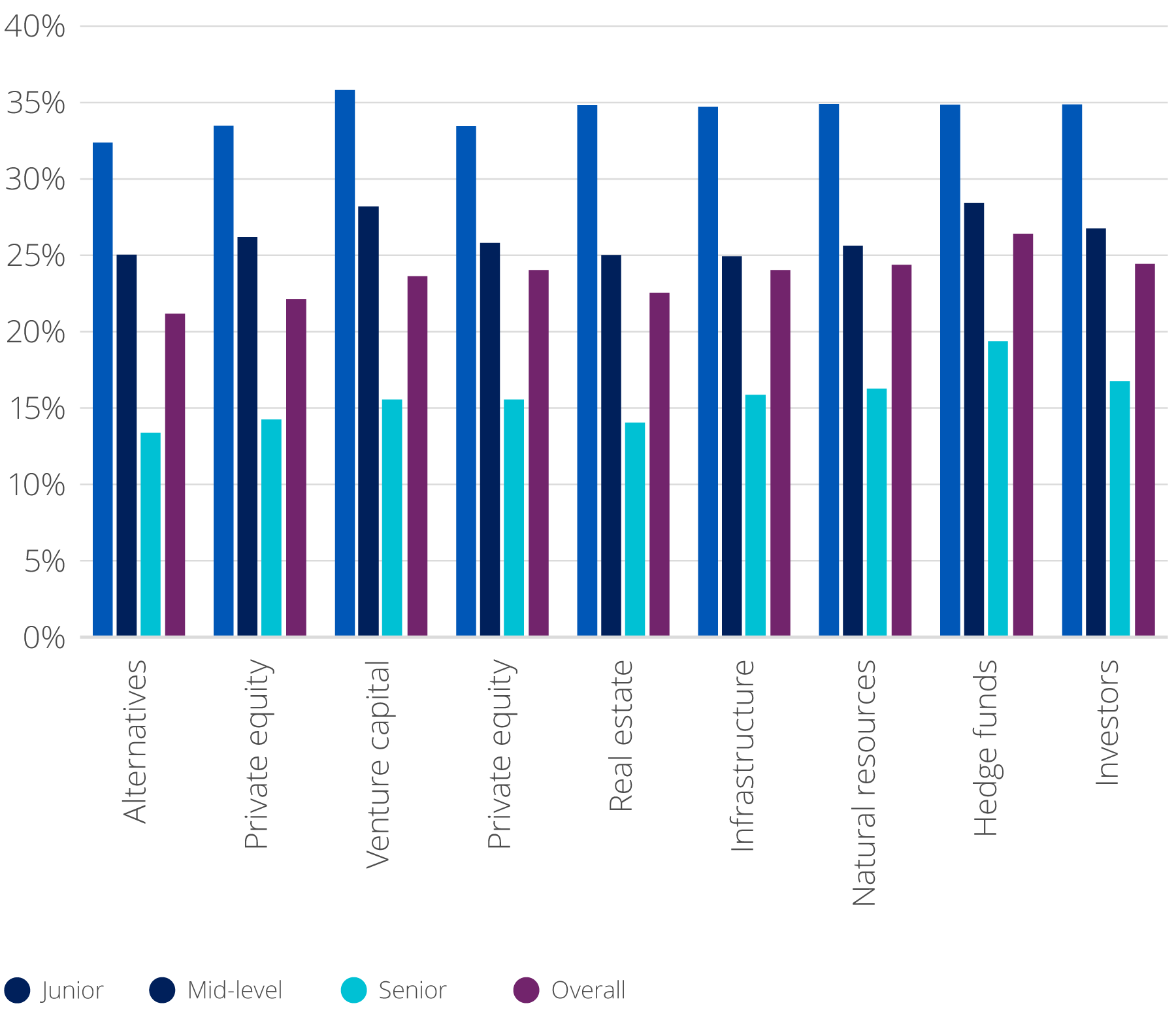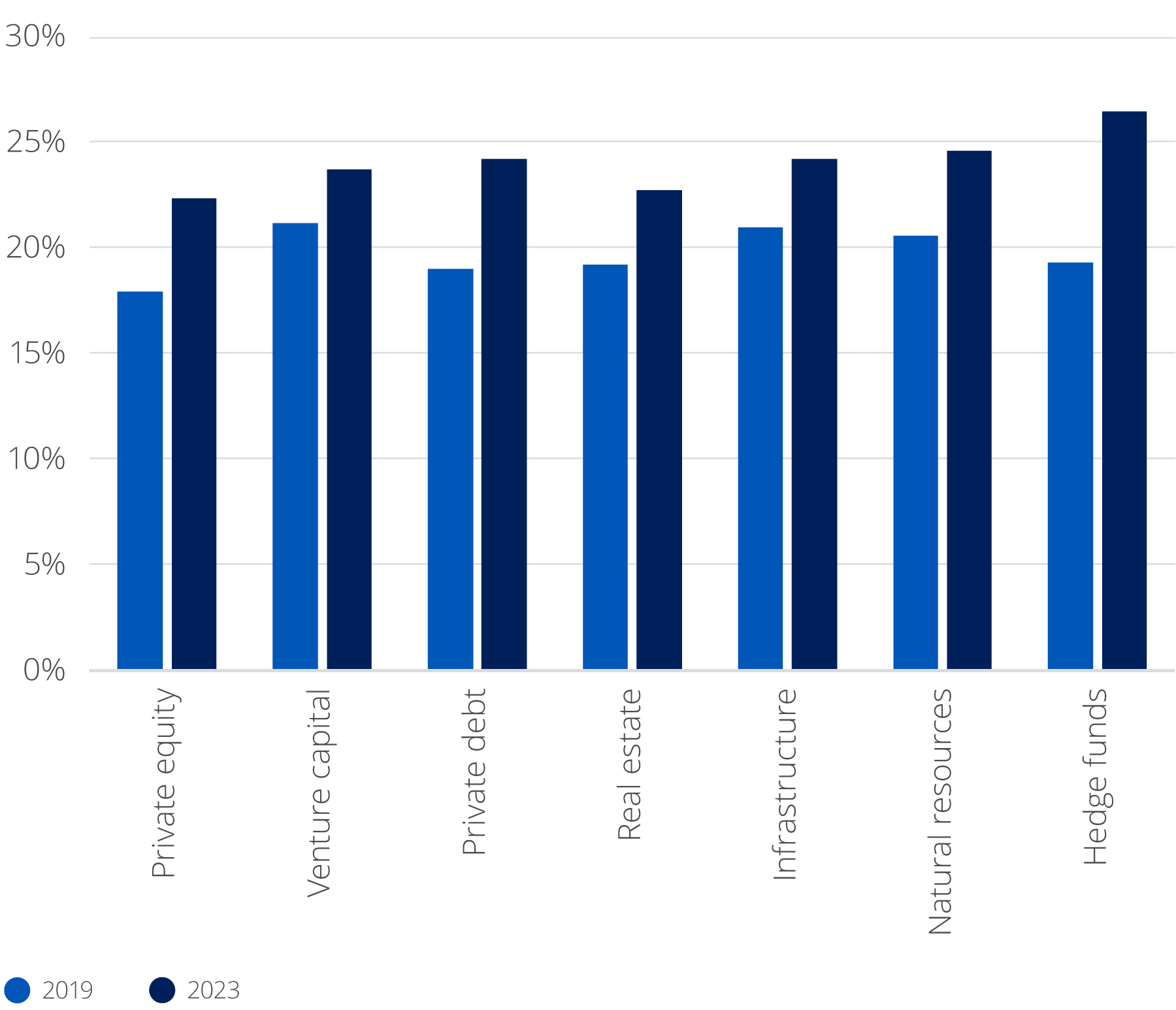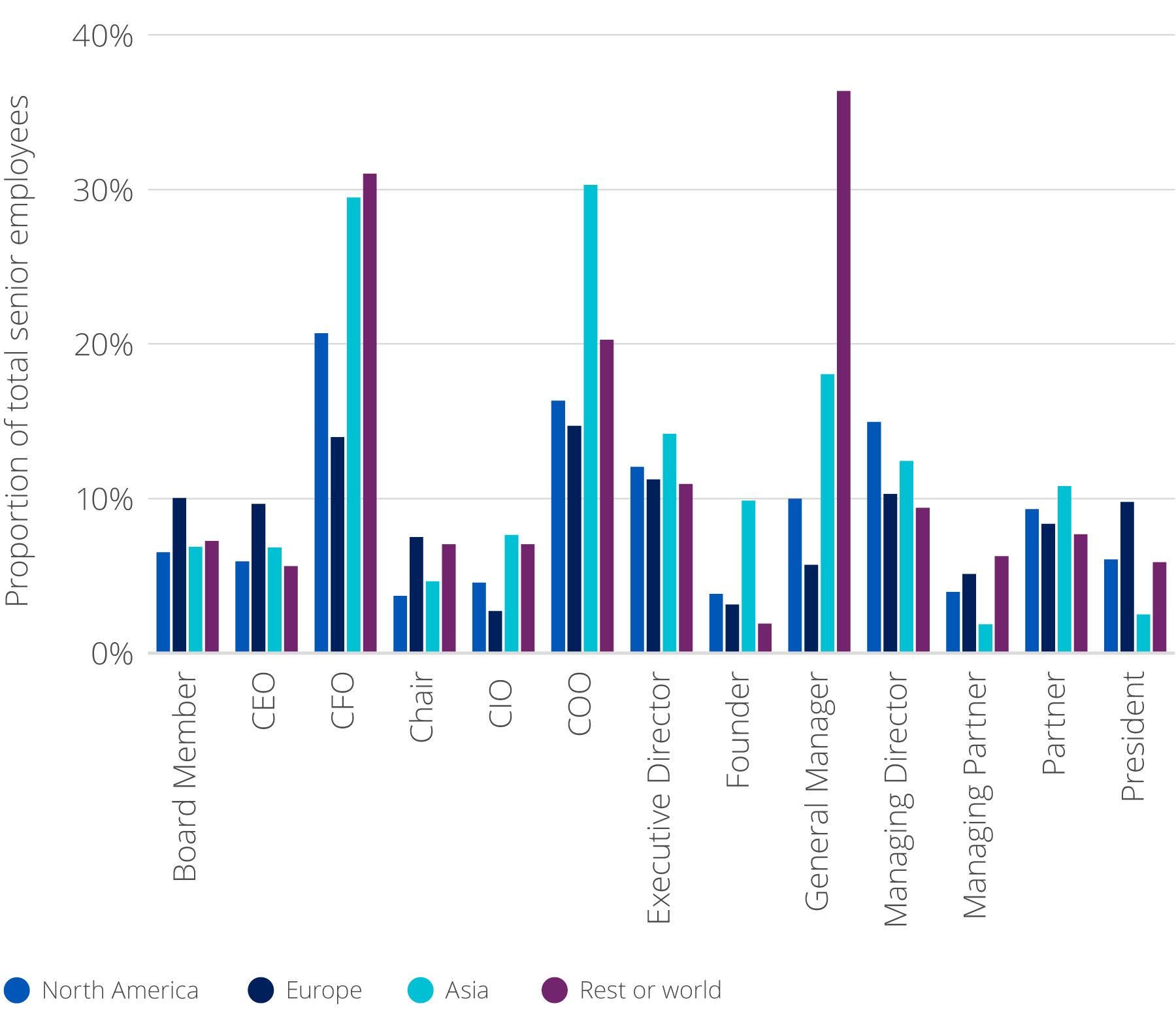As we think about different ways in which we can ‘source’ diversity of thought, gender diversification is paramount on that list. Let's start by exploring current figures highlighting women in the alternative industry today:
Women in Alternatives Today
- Women represent only 21.3% of people working in the alternatives industry
- At senior levels this number falls to 13.6%
Figure 1: Female employees in Alternatives as a proportion of total employees by seniority & asset class

Figure 2: Female employees in alternatives as a proportion of total employees by asset class, 2019 vs 2023

- Women, however, remain under-represented in investment decision-making roles, such as investment process, trading and portfolio management at 21.9%
Source: Preqin, ‘23
Figure 3: Women in senior roles at hedge funds as a proportion of all senior positions, by role and region

- As a result, hedge funds run by white men at executive or partner levels are estimated to manage 97% of the industry’s investments
Source: Preqin, ‘23
There are clearly social and ethical arguments for fostering women-owned and/or managed hedge funds as well as an enormous amount of well-documented evidence supporting the benefits of diversity within any team. More perspectives leads to higher quality decision making, better ability to attract and retain talent, and improved business results and longevity. We’re not suggesting that women are better or worse investors than men. On the contrary, men and women are different, and it’s those differences that create another vantage point when seeking to achieve diversified portfolios.
Outside of the social case, there is also increasing evidence of a supportive investment case as well. A 2021 study conducted by Goldman Sachs found that 48% of female-managed hedge funds beat the market between the market low in March ’20 through to August ‘21 – compared to 37% of male-led funds.3 Studies by HFR over longer periods reflect the same picture, with women-managed funds outperforming their male peers between the dot-com crash of January ‘00 and the end of the global financial crisis in May ’09.
But what explains the relative outperformance of women-managed funds versus the aggregate hedge fund benchmarks? We would argue that a positive ‘selection bias’ impacts the benchmarks that track women-managed hedge funds, which partially explains this outperformance. Because of the challenges that women in finance have had to contend with, relative to men, there is a ‘quality premium’ built into women-led funds and benchmarks. To be successful, women have had to be disproportionately as talented as their male counterparts to reach the same level. So, for a woman to have reached the point of launching a fund, hiring a team, building a business, raising capital, this means they are likely to be exceptional and driven investors – above those of the more diluted talent pool of male-led funds.
As it relates to the social and ethical case to be made, fostering women-managed funds in the industry is a critical step in the right social direction. It seems that the most direct way to correct this inequality on the buy-side - and reap the benefits from diversification - is to consciously and actively invest in women and be a catalyst for change. The prospect of an active investment in women-managed funds will also encourage the ushering in and promoting of women into senior positions, as it will increase the likelihood that the fund will receive a diversity inflow. Does it matter why a woman is promoted into a more senior role? Maybe it does. But in the short run we need change, and getting more women in those senior seats is a great start.
Screening, sourcing, filtering, diligencing, and investing in hedge funds is difficult and time consuming. Simply identifying or sourcing funds managed by women has proven challenging. Further, once these funds are identified, after investment due diligence, operational due diligence and all other steps in the investment process, the resulting fund that makes it through the process will ultimately receive an allocation. And that’s great. But how much social good does that approach actually achieve? The women-led fund that makes it through the process is likely already at critical mass and has “made it”. Smaller, more emerging women-managed funds are the groups that could really benefit from a larger asset base, and they will likely be screened out earlier in the process due to inadequate AUM or other considerations.
For all the reasons highlighted, we feel a passive approach to supporting women-managed hedge funds is the most prudent path from both a performance and social perspective. abrdn has an exclusive relationship with HFR, the leading hedge fund benchmarking company in the industry. This relationship allows abrdn to deliver passive exposure to their underlying indices, via a physical replication of their indices.
Using this passive approach, via an allocation that tracks the HFRI Women’s Access Index, addresses a number of issues and produces a variety of benefits:
- Speed to market; begin making a social impact and allocating capital considerably more quickly than what would be the case if sourcing, diligencing, negotiating and structuring funds on an individual basis.
- Impact: Be the catalyst for change; having a passive, rules-based approach to inclusion in the HFR Women Access Index will encourage the promotion of women into senior positions at hedge funds, knowing that if the fund simply meets the criteria it will get included in the index.
- Address the target market / avoid size bias; gain access to firms/funds that are smaller and may not otherwise be eligible for an allocation. These are precisely the firms that would most benefit from an allocation from the Women Access Index and are the funds that are explicitly targeted by the overall mission (via low minimum AUM thresholds for inclusion in the underlying index).
- Immediate diversification; reduce idiosyncratic/single manager risk and gain diversification considerably more quickly than through allocations to individual funds. While this concept is fairly obvious given the diversified nature of the Women Access Index (~30 underlying constituents and growing), the performance of female-focused programs will be an area of interest for the outside world. Thus, a targeted solution aimed at reducing the risk of an individual fund’s underperformance; undermining the overall exercise in the eyes of skeptics.
Introducing a passive solution allows us to help more funds (emerging and established) and make a greater impact more quickly. There are other benefits associated with this index strategy including cost efficiency, economies of scale, and an attractive volatility profile (the relatively smaller size of the “key female risk-taker” universe means that volatility of the index at c. 5.7% p.a. compares well with alternative investment options and is not “watered down”). Finally, of course, there is the positive feedback and recognition for investors focusing on an important and underrepresented area of the hedge fund industry.
We are therefore advocating that institutional investors bring the diversity progress from their own hiring practices to those of external providers, while sending a message to the wider investment community that this issue is to be taken seriously. We challenge investors to be pioneers and thought leaders in hedge fund diversity at this critical time.
A simple investment solution for a complex asset class
Launched in October 2019, the abrdn HFR Women Access Index is designed to deliver exposure to female portfolio management expertise, the abrdn HFR Women Access Fund concept will track the index launched by HFR in October 2019. Its aim is not to simply help women-owned funds, but target all funds where women play a key role in the management of a portfolio (e.g., through critical investment or risk-taking roles). Other index eligibility criteria include:
- Report monthly returns in USD
- Report net of all fees returns
- Report assets under management
- Be open to new investments
- Provide quarterly redemption liquidity or better
- AUM >$70m
At present there are ~30 underlying equally-weighted holdings. The index is rebalanced on a quarterly basis and offers quarterly liquidity with no lock-up or gates. Critically, performance of the index has kept pace with the investable HFRI 500 and non-investable HFRI Fund Weighted Composite indices since inception and outperformed for much of that period – indicating that the “female premium” is real.
See Figs 4 & 5 below.
Figure 4: Performance of abrdn HFR Women Access Index vs main HF benchmarks
Source: abrdn, Feb '23
Figure 5: Performance during 10 worst months for S&P 500
Source: abrdn, Dec '22
Sources:
Preqin – Women in Alternatives 2023 report
“Hedged Out: Inequality and Insecurity on Wall Street” by Megan Tobias Neely, Associate Professor - Department of Organization at Copenhagen Business School and a former postdoctoral fellow at the Clayman Institute.
GS Diversity Report, March 2022
IMPORTANT INFORMATION
HFR 500 Fund of Funds Composite invest with multiple managers through funds or managed accounts. The strategy designs a diversified portfolio of managers with the objective of significantly lowering the risk (volatility) of investing with an individual manager.
HFRI 500 Fund Weighted Composite Index is an investable global, equal-weighted index of the largest hedge funds that report to the HFR Database which are open to new investments and offer quarterly liquidity or better.
HFRI Fund Weighted Composite Index is a non-investable global, equal-weighted index of single-manager funds that report to the HFR Database.
HFRI Equity Hedge: Long/Short Directional - a global, equal-weighted index of single-manager funds that report to the HFR Database. It is comprised of Equity Hedge funds that are not considered Equity Market Neutral. It includes funds that are classified as Fundamental Growth, Fundamental Value, Multi-Strategy, Quantitative Directional and sector-focused (i.e., Energy/Basic Materials, Healthcare and Technology).
HFRI EH: Equity Market Neutral Index- the index focuses on strategies which employ sophisticated quantitative techniques of analyzing price data to ascertain information about future price movement and relationships between securities, select securities for purchase and sale. These can include both Factor-based and Statistical Arbitrage/Trading strategies.
HFRI 500 Event Driven Merger Arbitrage – the index focuses on strategies which employ an investment process primarily focused on opportunities in equity and equity related instruments of companies which are currently engaged in a corporate transaction.
HFRI 500 Macro Discretionary - the index focuses on which strategies employ an investment process most heavily influenced by top down analysis of macroeconomic variables
HFRI Event-Driven: Multi-Strategy –the index focuses on Multi-Strategy Managers maintain positions in companies currently or prospectively involved in corporate transactions of a wide variety including but not limited to mergers, restructurings, financial distress, tender offers, shareholder buybacks, debt exchanges, security issuance or other capital structure adjustments..
HFRI 500 Macro Systematic – the index focuses on strategies which employ an investment process designed to identify opportunities in markets exhibiting trending or momentum macro based characteristics across individual instruments or asset classes.
HFRI Relative Value : Fixed Income Directional Index - a global, equal-weighted index of single-manager funds that report to the HFR Database. The index is comprised of Relative Value funds that are classified as RVA: Fixed Income - Sovereign, RVA: Fixed Income - Convertible Arbitrage, RVA: Fixed Income - Corporate and RVA: Fixed Income - Asset Backed.
HFRI Relative Value: Volatility Index – the index focuses on strategies which trade volatility as an asset class, employing arbitrage, directional, market neutral or a mix of types of strategies, and include exposures which can be long, short, neutral or variable to the direction of implied volatility, and can include both listed and unlisted instruments. Directional volatility strategies maintain exposure to the direction of implied volatility of a particular asset or, more generally, to the trend of implied volatility in broader asset classes. Arbitrage strategies employ an investment process designed to isolate opportunities between the price of multiple options or instruments containing implicit optionality. Volatility arbitrage positions typically maintain characteristic sensitivities to levels of implied and realized volatility, levels of interest rates and the valuation of the issuer's equity, among other more general market and idiosyncratic sensitivities.
HFRI 500 Equity Hedge Index: The HFRI 500 Equity Hedge Index is a global, equal-weighted index of the largest hedge funds that report to the HFR Database which are open to new investments and offer quarterly liquidity or better. The Equity Hedge funds that comprise the index are a subset of the HFRI 500 Fund Weighted Composite Index. The index is rebalanced on a quarterly basis.
HFRI 500 Event-Driven Index: The HFRI 500 Event Driven Index is a global, equal-weighted index of the largest hedge funds that report to the HFR Database which are open to new investments and offer quarterly liquidity or better. The Event Driven funds that comprise the index are a subset of the HFRI 500 Fund Weighted Composite Index. The index is rebalanced on a quarterly basis.
HFRI 500 Macro Index: The HFRI 500 Macro Index is a global, equal-weighted index of the largest hedge funds that report to the HFR Database which are open to new investments and offer quarterly liquidity or better. The Macro funds that comprise the index are a subset of the HFRI 500 Fund Weighted Composite Index. The index is rebalanced on a quarterly basis.
HFRI 500 Fund Weighted Composite Index: The HFRI 500 Fund Weighted Composite Index is a global, equal-weighted index of the largest hedge funds that report to the HFR Database which are open to new investments and offer quarterly liquidity or better. The index constituents are classified into Equity Hedge, Event Driven, Macro or Relative Value strategies. The index is rebalanced on a quarterly basis.
HFRI 500 Relative Value Index: The HFRI 500 Relative Value Index is a global, equal-weighted index of the largest hedge funds that report to the HFR Database which are open to new investments and offer quarterly liquidity or better. The Relative Value funds that comprise the index are a subset of the HFRI 500 Fund Weighted Composite Index. The index is rebalanced on a quarterly basis.
Alternative investments involve specific risks that may be greater than those associated with traditional investments; are not suitable for all clients; and intended for experienced and sophisticated investors who meet specific suitability requirements and are willing to bear the high economic risks of the investment. Investments of this type may engage in speculative investment practices; carry additional risk of loss, including possibility of partial or total loss of invested capital, due to the nature and volatility of the underlying investments; and are generally considered to be illiquid due to restrictive repurchase procedures. These investments may also involve different regulatory and reporting requirements, complex tax structures, and delays in distributing important tax information.
Hedge funds use sophisticated investment strategies that may increase investment risk in your portfolio. Among the risks presented by hedge fund investments are: the use of unregistered investments, which may make it difficult to assess the performance of the holding; risky investment strategies, which may result in significant losses; illiquid investments that may be subject to restrictions on transferability and resale; and adverse tax consequences.
US-180423-191077-1